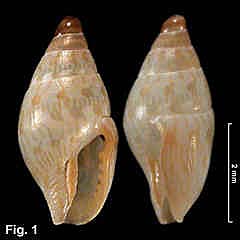|
|
|
|
|
Anachis fulgida (Reeve, 1859) Description: Shell variable in height to width ration, translucent or opaque, whorls slightly convex, aperture more than 1/3 of shell length. Axial sculpture absent. Spiral sculpture restricted to a few cords on base. Outer lip sinuous in profile with shallow posterior sinus, not thickened externally; thickened internally, with 4 denticles, the uppermost largest. Columella smooth, callus sharp-edged. Siphonal canal slightly upturned, notch moderately deep. Colour opaque white or translucent, usually with wavy axial tan lines in 2 spiral bands; the lines formed into groups of 4 or 5, joined by an inclined line above; a row of white spots above suture and at centre of body whorl, and sometimes a white band below suture. Size: Up to 6 mm in length. Distribution: Endemic to Australia; Laurieton, NSW, southwards to SA and Tasmania. Habitat: Known from beach shells and down to 150 m. Moderately common. Comparison: Anachis atkinsoni is similar to this species, but is more slender, is often axially ribbed, and has no denticles inside the outer lip even when fully mature. It is much more common. Anachis lurida is half the size, with a much smaller protoconch. Although axial brown lines may be present in other species of the genus, they are closer and more distinct in this species. Synonymy: Columbella angasi Brazier, 1871; Columbella interrupta Angas, 1865; Columbella minuta Tenison-Woods, 1876. Remarks: Shells from NSW are fairly constant in colour pattern but variable in height to width ratio. In southern Australia shells lacking the brown lines are common, and in South Australia, the pattern changes into a number of variations, as described by Verco (1910, p. 137). Fig. 1: Flinders, Victoria (C.103829)
|
